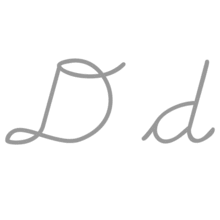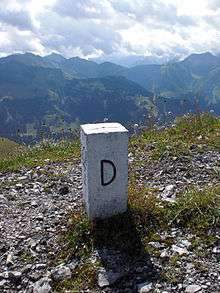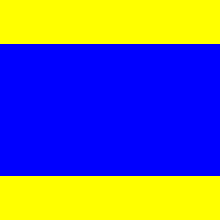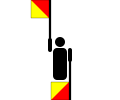D
|

D (named dee /ˈdiː/[1]) is the fourth letter of the modern English alphabet and the ISO basic Latin alphabet.
History
| Egyptian hieroglyph door |
Phoenician daleth |
Greek Delta |
Etruscan D |
Roman D | ||
|---|---|---|---|---|---|---|
|
|
|
|
|
The Semitic letter Dāleth may have developed from the logogram for a fish or a door. There are many different Egyptian hieroglyphs that might have inspired this. In Semitic, Ancient Greek and Latin, the letter represented /d/; in the Etruscan alphabet the letter was superfluous but still retained (see letter B). The equivalent Greek letter is Delta, Δ.
The minuscule (lower-case) form of 'd' consists of a loop and a tall vertical stroke. It developed by gradual variations on the majuscule (capital) form. In handwriting, it was common to start the arc to the left of the vertical stroke, resulting in a serif at the top of the arc. This serif was extended while the rest of the letter was reduced, resulting in an angled stroke and loop. The angled stroke slowly developed into a vertical stroke.
Use in writing systems

In most languages that use the Latin alphabet, and in the International Phonetic Alphabet, ⟨d⟩ generally represents the voiced alveolar or voiced dental plosive /d/. However, in the Vietnamese alphabet, it represents the sound /z/ in northern dialects or /j/ in southern dialects. (See D with stroke and Dz (digraph).) In Fijian it represents a prenasalized stop /nd/.[2] In some languages where voiceless unaspirated stops contrast with voiceless aspirated stops, ⟨d⟩ represents an unaspirated /t/, while ⟨t⟩ represents an aspirated /tʰ/. Examples of such languages include Icelandic, Scottish Gaelic, Navajo and the Pinyin transliteration of Mandarin.
Other uses
- The Roman numeral Ⅾ represents the number 500.[3]
- D is the grade below C but above E in the school grading system.
Related characters
Descendants and related characters in the Latin alphabet
- Ð ð : Latin letter Eth
- D with diacritics: Đ đ Ɗ ɗ Ḋ ḋ Ḍ ḍ Ḑ ḑ Ḓ ḓ Ď ď Ḏ ḏ
- IPA-specific symbols related to D: ɖ
Ancestors and siblings in other alphabets
- 𐤃 : Semitic letter Dalet, from which the following symbols originally derive
Derived signs, symbols and abbreviations
- ₫ : Dong sign
- ∂ : the partial derivative symbol,
Computing codes
| Character | D | d | ||
|---|---|---|---|---|
| Unicode name | LATIN CAPITAL LETTER D | LATIN SMALL LETTER D | ||
| Encodings | decimal | hex | decimal | hex |
| Unicode | 68 | U+0044 | 100 | U+0064 |
| UTF-8 | 68 | 44 | 100 | 64 |
| Numeric character reference | D | D | d | d |
| EBCDIC family | 196 | C4 | 132 | 84 |
| ASCII 1 | 68 | 44 | 100 | 64 |
- 1 Also for encodings based on ASCII, including the DOS, Windows, ISO-8859 and Macintosh families of encodings.
Other representations
In British Sign Language (BSL), the letter 'd' is indicated by signing with the right hand held with the index and thumb extended and slightly curved, and the tip of the thumb and finger held against the extended index of the left hand.
References
- ↑ "D" Oxford English Dictionary, 2nd edition (1989); Merriam-Webster's Third New International Dictionary of the English Language, Unabridged (1993); "dee", op. cit.
- ↑ Lynch, John (1998). Pacific languages: an introduction. University of Hawaii Press. p. 97. ISBN 0-8248-1898-9.
- ↑ Gordon, Arthur E. (1983). Illustrated Introduction to Latin Epigraphy. University of California Press. p. 44. ISBN 9780520038981. Retrieved 3 October 2015.
External links
| Wikimedia Commons has media related to D. |


